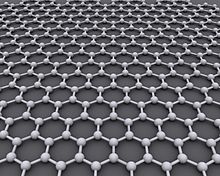2D materials

2D materials are crystalline materials that consist of only one layer of atoms or molecules . Due to their unusual properties, they are the subject of extensive (basic) research.
In general, 2D materials can be viewed either as two-dimensional allotropes of different elements or as a combination of different elements with a covalent bond . Elementary 2D materials generally have the ending -en ( English -ene ), while connecting materials have the ending -an or -id ( English -ane or ide ).
history
2D materials have been known for over a hundred years, e.g. B. in the form of graphs as 2-dimensional carbon . In 2004 Andre Geim and Konstantin Novoselov succeeded in producing the first two-dimensional crystals from carbon atoms (graphene) at the University of Manchester , a discovery for which they received the 2010 Nobel Prize in Physics “ for fundamental experiments with the two-dimensional material graphene ”.
As a result, extensive research into other 2D materials has been initiated worldwide. Since 2D materials can consist of a single layer, but also of two or more layers, the question arises as to how many layers one no longer needs from z. B. graphene, but graphite must speak. That is why the terms and definitions of 2D materials are set internationally in the ISO / TS 80004-13: 2017 standard.
2D allotropic materials
Examples of elementary allotropes:
- Carbon : graphene
- Boron : Borophene
- Gallium : bile
- Germanium : Germanic peoples
- Silicon : silicene
- Tin : Stanen
Two-dimensional structures are also known from metal alloys.
2D connection materials
Examples of 2D connector materials:
- Graphane (a two-dimensional polymer made of carbon and hydrogen )
- Boronitrene ( Nanomesh - two-dimensional boron nitride , also English White Graphene )
- Germanium phosphide
- Molybdenum (IV) sulfide , which as a 2D material has a direct band gap in contrast to the 3D crystal .
Applications
Due to their unusual properties, 2D materials are being studied for a wide range of applications, e.g. B. as electrical or electronic components (semiconductors), bioengineering , medical applications, as energy storage , etc. Because of their small thickness, 2D materials enable the extreme scaling of the structures of integrated circuits , as investigations of the IMEC on molybdenum disulfide show.
Individual evidence
- ^ The Nobel Prize in Physics 2010. The Nobel Foundation , accessed March 15, 2018 .
- ^ Anna Demming: Graphene meets the standard for industry. Physics World , March 14, 2018, accessed August 14, 2018 .
- ↑ ISO / TS 80004-13: 2017. Nanotechnologies - Vocabulary - Part 13: Graphene and related two-dimensional (2D) materials. International Organization for Standardization, September 2017, accessed March 15, 2018 .
- ↑ Borophene - a new miracle material? In: Technology Review. heise online , April 18, 2019, accessed on April 18, 2019 .
- ↑ Neil Tyler: Flat gallium joins roster of new 2-D materials. New Electronics , March 12, 2018, accessed March 15, 2018 .
- ↑ Graphene meets gallenene-A straightforward approach to developing large-area heterosexual stacks by gallium self-propagation . 2019, arXiv preprint arXiv: 1905.12438
- ↑ Christian Kahle: Graphene is just the beginning: Researchers are finding more 2D material. WinFuture.de, February 10, 2017, accessed on March 15, 2018 .
- ^ Mak, Lee, Hone, Shan, Heinz: Atomically Thin MoS2: A New Direct-Gap Semiconductor. In: Physical Review Letters. American Physical Society , September 24, 2010, accessed May 9, 2018 .
- ↑ Made in IBM Labs: IBM Scientists Demonstrate World's Fastest Graphene Transistor. Holds Promise for Improving Performance of Transistors. IBM , February 5, 2010, accessed March 15, 2018 .
- ↑ Jennifer Marcus: Researchers develop graphene supercapacitor holding promise for portable electronics. Phys.org , March 15, 2012, accessed March 15, 2018 .
- ^ Neil Tyler: 2D materials paving the way to extreme scaling. New Electronics, December 9, 2019, accessed December 10, 2019 .
